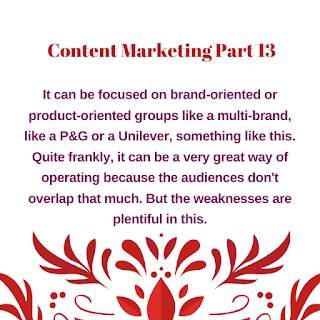The other is how we're going to create a function for content, a strategy for content. Put simply, it's not a campaign. It's a process that will ultimately build content products. That is what a content marketing strategy is-- a process that helps us build content-owned media products that drive multiple lines of value for the business.
And once we've got that function defined, which we'll start to do today, is we're going to start doing things like writing the roles and responsibilities, making those roles and responsibilities real in the organization, formalize them. Writers that write will do so as part of their job.
Content creators who create, editors who edit, developers who develop will do so as part of their job of creating these content and marketing-oriented products. It has to be a recognized strategy. It has to be a documented strategy. It has to be something that the business does as part of its operation. Figure out those official content responsibilities.
Make a case for the liaison to the execution of whatever it's going to be. Make a governing body. Have your boss understand that what we're building here is a function, not just a project.
So let me give you a couple of examples of this. So we have many, many frameworks that we've seen in all of our histories at the Content Marketing Institute. And a few of them have weaknesses, strengths, and pros and cons. And so we'll go through a few of them here.
So a center of excellence framework. When we look at this, it's a central area. So this is probably the least common these days, but maybe the most popular way of thinking about a content marketing group. Think of this as the content marketing department where there's going to be a fully realized function of content marketing in the business. So the strengths of this?
You have a high degree of control. You've got people in there who focus on creating these content marketing properties, who focus on content marketing, who focus on aligning with the business. And it's very, very clear missions and very, very clear responsibilities. Now the weaknesses here are we've got to make sure that this doesn't yet become another silo, that it's not disconnected from the other marketing functions.
And quite frankly, this becomes very hard to scale. We can't really scale it without actually building more teams, more processes, et cetera. But it can be very, very effective if you're looking to centralize the function of content marketing in an enterprise.
Or, another one is what we call the rebel framework. The rebel framework is how many organizations start with content marketing because each line of business or each function-- PR brand, demand, generation, et cetera-- basically launches their own content marketing initiative and works in their own line of business, in their own silo, to create content marketing strategies. This in many ways can be the best way to start because in many businesses it's the only way to start.
If we're trying to get a committee together, if we try to get all these people together, it's just not going to work. So what happens is when we start processing this and creating a function over this, it becomes loosely siloed and connected groups that are working together on best practices. So the strengths of this start are it can be entrepreneurial in nature.
It can be focused on brand-oriented or product-oriented groups like a multi-brand, like a P&G or a Unilever, something like this. Quite frankly, it can be a very great way of operating because the audiences don't overlap that much. But the weaknesses are plentiful in this.
There's no leverage across these silos. There's no integration and no institutional learning here, no sharing. So each one fails or succeeds in its own silo. And the organization, the enterprise, doesn't benefit from the knowledge there. And so our favorite, the way that we'd love to see our organizations begin to develop, is what we call the integrated and/or hybrid network where content marketing as a process becomes an integrated function into the marketing strategy more broadly.
And so where we're seeing that all sorts of integrations are happening, right. Lots of ears to the ground. We can take on a centralized process for some services, but leave the lines of businesses to create subject matter expertise or content for their particular line of business where necessary. Now the weaknesses here-- they're harder to build.
There's a lot of politics here. Knowing where best practices end and begin, and knowing where content creators end and begin, and limiting the size so that it yet also doesn't become a centralized and/or become its own silo is really, really difficult here.
Which one of these is right for you? That's for you to determine. But this is the key-- trying to figure out what we're building a business case here for is the function. Because these roles will turn into actual responsibilities. So when we see the responsibilities of content marketing really, really working, we see a few roles. One is the chief content officer. Now despite the title of this, this doesn't necessarily mean a VP or director or even a senior-level manager.
And some of the companies we've seen, the chief content officer can be a manager who comes from publishing, maybe who comes with editing skills. But this is the person who can determine and synthesize all the sort of stories that are being mined out of the organization into something that is meaningful for the audience, into something. So they're usually a great project manager, usually a visionary, usually somebody who can manage all the different personalities and lead the strategy of content marketing more broadly.










No comments:
Post a Comment